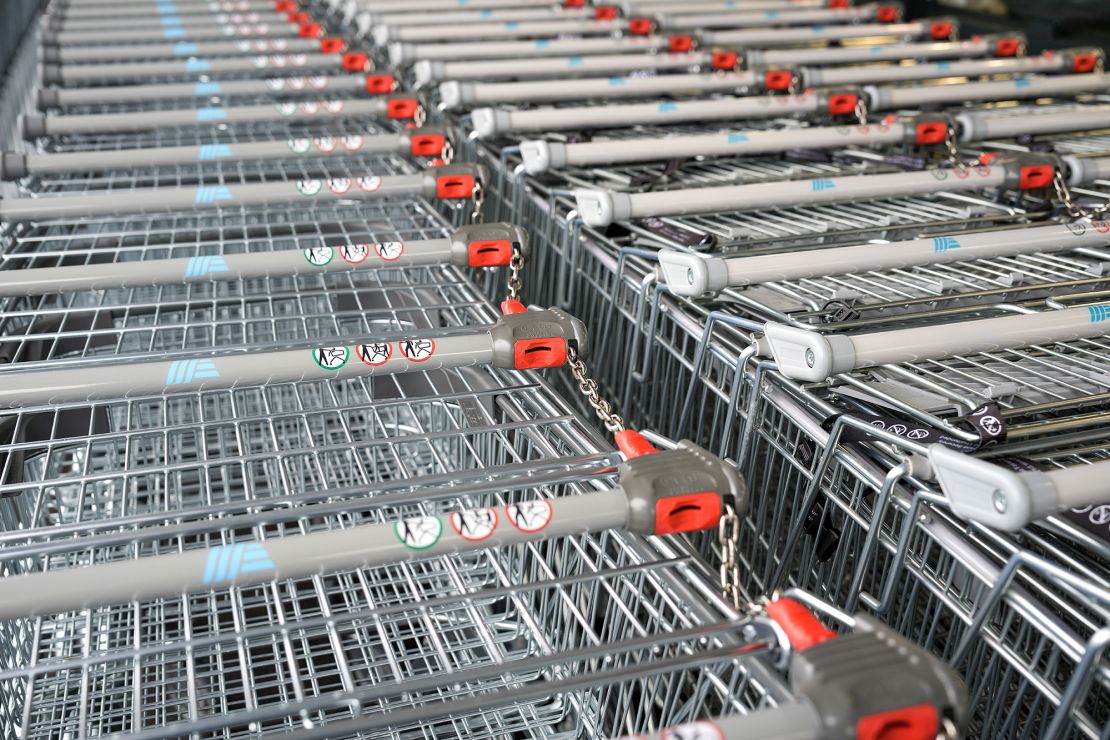It’s an almost-inevitable part of any shopping trip. You enter a store to grab a few necessities and find yourself pushing, pulling, lifting and/or dragging your cart up the baking aisle as the one wheel with a mind of its own squeaks and stalls against the linoleum.
A long-circulating urban myth holds that retailers deliberately make the carts unwieldy to slow your roll down the aisle, hoping to divert your attention to more merchandise. But the national frustration is not the work of a business psychology mastermind.
The notoriously combative wheels are actually created by the repeated battering that shopping carts are often subject to, explained Alex Poulos. Poulos is the sales director for R.W. Rogers, which supplies thousands of shopping carts to companies like Whole Foods, Tractor Supply Company and Meijer.
Grocery store carts are more likely to have carts with wonky wheels than other types of retailers, like clothing stores or drugstores, where the carts don’t leave the store as much; merchandifse is typically carried out in a bag or two. That’s because they are exposed to the elements much more often, and that environmental damage affects the wheels. The primary culprit, however, is often not the wheel itself, but the way it’s attached to the cart.
Over time, pulling carts through bumpy parking lots, wrestling them across the threshold of doorways in and out of the store, and forcing them up and down the curb warps the caster plate, the metal piece that attaches the wheel mechanism to the cart’s body, Poulos told CNN.
“If that caster plate gets twisted just a little, it might lift the wheel up, and then both wheels are not touching the ground at the same time,” he said.
In a perfect world where carts were handled gently and utilized only indoors, the standard five-inch polyurethane shopping cart wheel could last between six and eight years, said Alvar Diaz, vice president of Sales and Marketing at wheel and caster manufacturing company P&H Casters. In a 24/7 store environment, they’re more likely to last two or three years, while the metal casters last for about five.
But replacing the wheel without paying attention to the plate and the nuts and bolts that keep everything together means that a new wheel can be just as wobbly as an older one.
Consumers bear some of the responsibility for the banged up and broken qualities of their shopping carts.
Carts that are abandoned outside after shoppers load their food into their vehicles are at the mercy of extreme heat, snow, ice and road salt. That prolonged exposure can damage the cart and its wheels.
To combat this, grocery retailers in Europe, such as Aldi, Tesco and Lidl, have coin locks on their carts. Customers insert a coin to “check out” a cart, which they get back when they return the cart to its original place at the end of their shopping trip.

This system, although not mainstream in the United States, makes for much longer-lasting carts and fewer wobbly wheels.
“Coin locks make sure the carts are always where they’re supposed to be,” said Poulos. “They ensure that the carts are maintained better and that (their) longevity is better because they’re not sitting in a snowbank or blown over by the wind. You also don’t need the labor to hunt them down and bring them back to the front of the store.”
One way to enhance durability is by changing the material of the wheels from the typical polyurethane to pricier rubber.
Rubber wheels have been a mainstay of motorized shopping carts for decades, said Beth Thieme, president and CEO of Amigo Mobility, which produced the first motorized cart in 1968.
A smooth and steady ride is absolutely necessary for these carts used by customers with mobility challenges. Therefore, these carts use rubber wheels with no casters or caster plates, meaning they can’t swivel or get stuck.
Retailers and manufacturers have taken note of this design. Several major chains like Walmart and Target have begun using rubber wheels in their carts.
While the rubber wheels cost twice the price of the standard polyurethane ones, Diaz said P&H Casters’ natural rubber wheels can last for about a decade, barring mistreatment from customers. In a busier store environment, they can hold out between four and five years.
However, many retailers choose cheaper parts because the upfront price is typically higher for more durable material, Poulos added. These companies end up needing to replace these parts more often as they get twisted and deformed, but these tasks — much like the carts — sometimes fall between the cracks.
Read the full article here



